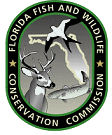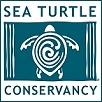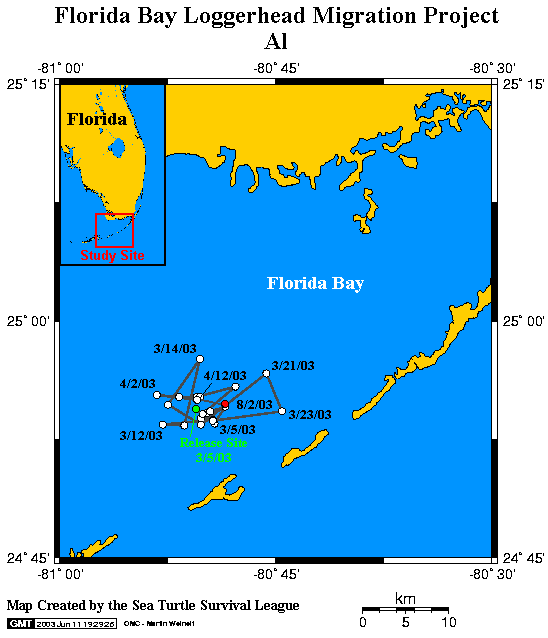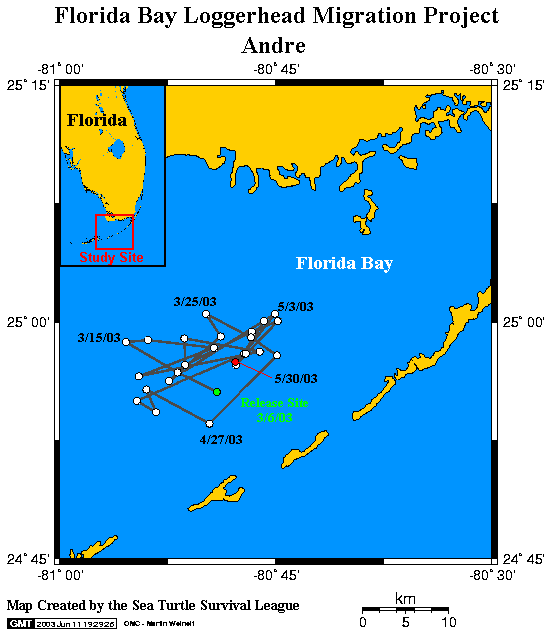During March, 2003, researchers Barbara Schroeder (National Marine Fisheries Service), Allen Foley (Florida Fish and Wildlife Conservation Commission – Florida Marine Research Institute) and Blair Witherington (FWCC – FMRI), captured and attached satellite transmitters to eight loggerhead sea turtles as part of their studying of the movements and diving patterns of adult male and female loggerheads captured in Florida Bay.
    |
Loggerhead turtles were captured during March of 2003 and examined using ultrasound and laparoscopic techniques to determine their reproductive status. Eight turtles (five male and three female) were identified as expected to breed during the 2003 breeding season. These eight turtles were outfitted with satellite transmitters to allow us to follow their movements remotely. The selection of turtles that are preparing to breed will allow us to remotely study their migratory route(s) and schedule(s) that will take females to their nesting beaches and males to their mating areas. There have been no similar studies conducted on southeast U.S. loggerheads. The five male loggerheads outfitted with satellite tags are Andre, Al, Dave, Flash, and Walt. The three females are Bitsy, Emily, and Mango.
Project Background: Florida Bay, at the southern terminus of the Florida peninsula, is known to be extensively used by sea turtles. Four sea turtle species known from Florida Bay are the loggerhead, green turtle, hawksbill, and Kemp’s ridley. As part of a multi-disciplinary program aimed at restoration of the south Florida ecosystem, including Florida Bay and the Everglades, this project contributes important information about a prominent protected resource within Florida Bay. The long-term population study of Florida Bay sea turtles is providing information that is directly applicable to management questions regarding the status of the federally protected loggerhead in the southeast United States. Genetic studies have identified Florida Bay as a mixed stock foraging habitat, with individuals represented from all of the major loggerhead populations in the central western Atlantic. Past work has characterized Florida Bay as an important adult resident foraging habitat, for both female and male loggerheads. Additionally, researchers have documented the debilitating and often fatal disease, fibropapillomatosis, as an affliction of Florida Bay green turtles and loggerheads.
This is a Joint Project Between the National Marine Fisheries Service and Florida Fish and Wildlife Conservation Commission and is funded by the Disney Wildlife Conservation Fund.
For more information on sea turtles, check out the Sea Turtles Information section of our website.
Click on the turtle’s name to see a map of its movements.
AL – A male loggerhead satellite tagged on March 5, 2003. Al measured 101.5 cm in shell length and weighed 120 kg. His transmitter is still sending signals, but hasn’t transmitted a location point since May 5, 2003.

ANDRE – A male loggearhead satellite tagged on March 6, 2003. Andre measured 100.5 cm in shell length and weighed 116 kg. His transmitter has not sent a signal since May 30, 2003.

BITSY – A female loggerhead satellite tagged on March 6, 2003. Nested near Floridana Beach, Fla on May 26, 2003 (seen by University of Central Florida researchers). Bitsy measured 90.8 cm in shell length and weighed 100 kg. Her transmitter is sending locations. Bitsy finished nesting and now back at her foraging grounds.

DAVE – A male loggerhead satellite tagged on March 4, 2003. Dave measured 90.0 cm in shell length and weighed 84 kg.

EMILY – A female loggerhead satellite tagged on March 4, 2003. Emily measured 94.3 cm in shell length and weighed 107 kg. As of September 8, 2003, Emily has returned home.

FLASH – A male loggerhead satellite tagged on March 7, 2003. Flash measured 95.6 cm in shell length and weighed 93 kg.

MANGO – A female loggerhead satellite tagged on March 5, 2003. Researchers believe she nested near the north end of Hutchinson Island, Fla on May 25, 2003 based on receiving two very good points on the beach during the early morning. Mango measured 98.0 cm in shell length and weighed 113 kg.

WALT – A male loggerhead satellite tagged on March 6, 2003. Walt measured 89.4 cm in shell length and weighed 82 kg.
